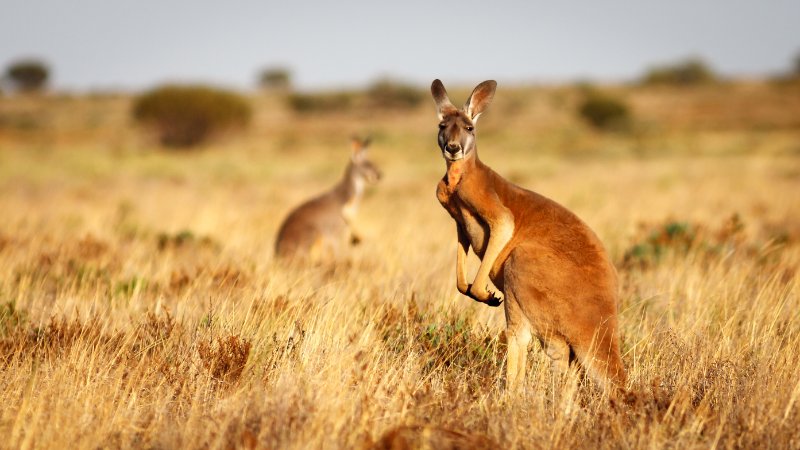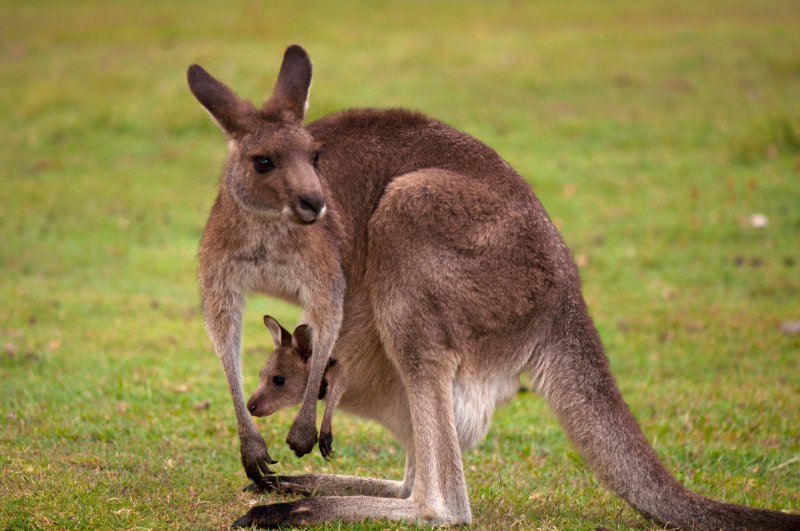Did you know that kangaroos are fascinating not just for their hopping ability but also for their unique reproductive practices? Kangaroo reproduction is truly intriguing and comes with an array of unusual facts. Let’s dive into the details.
Kangaroo reproduction is a fascinating aspect of these iconic Australian marsupials that has drawn considerable interest among biologists and wildlife enthusiasts. The reproductive process of kangaroos is distinguished by several remarkable adaptations that enable them to thrive in the often harsh and unpredictable environments of Australia.
For instance, female kangaroos possess the extraordinary ability to delay the development of an embryo until environmental conditions are favorable, a phenomenon known as embryonic diapause. This ensures that the timing of the joey’s birth and subsequent growth occurs during periods with abundant resources. Learn how kangaroos ensure genetic diversity and reproductive success through various strategies and adaptations.
At the core of kangaroo reproduction is the marsupial’s unique life cycle. After a gestation period that is relatively short compared to placental mammals, a kangaroo gives birth to an underdeveloped joey. The joey, blind and tiny at birth, instinctively crawls into its mother’s pouch where it latches onto a teat for nourishment.
The pouch acts as a nurturing haven where the joey continues developing safely insulated from external threats. As the joey matures, it begins to explore outside the pouch, though it returns for feeding and protection until it becomes independent. Learn about the macropod reproduction process, including embryonic diapause and pouch development.
Kangaroo Reproduction Overview
Kangaroo reproduction is a fascinating spectacle of nature highlighting a unique reproductive strategy and intricate courtship behaviors.
Reproductive Behavior
Kangaroos engage in a reproductive process that is exceptional among mammals. Their reproductive behavior is characterized by a short gestation period, typically around 30 days, after which a virtually embryonic joey is born. This immature newborn then crawls into its mother’s pouch where it continues to develop for several months.
Female kangaroos also can pause the development of an embryo through a process known as embryonic diapause, which ensures that the timing of the joey’s birth does not clash with the development of an older sibling still in the pouch.
Mating and Courtship
The courtship procedure for kangaroos involves a series of behaviors that signal reproductive readiness. A male kangaroo, or boomer, will typically court a female by sniffing, touching, and following her to exhibit his interest. Males may also engage in boxing as a show of strength to woo females or to deter rivals. Understanding this courtship ritual is crucial as it can influence a female’s receptiveness towards the male and subsequently the mating success.
Gestation and Birth
In the remarkable reproductive process of kangaroos, the gestation period is notably brief, followed by an exceptional phase of embryonic diapause, allowing survival in diverse environmental conditions. The birth of kangaroo joeys is equally intriguing, ensuring continuity of life through specialized adaptation.
Gestation Period
Kangaroos experience a gestation period spanning approximately 30 to 36 days, considerably shorter than that of placental mammals. The embryo develops rapidly and, despite its brief time in the womb, coincides with critical stages of embryo development before the newborn seeks shelter in the maternal pouch.
Birth Process
The birth of a kangaroo is a delicate affair. The underdeveloped joey, only the size of a grape, makes the precarious journey from the birth canal to the pouch unaided. Once nestled securely within, it latches onto a nipple, where it continues to develop, protected, and nourished, for several months.
Embryonic Diapause
A distinctive reproductive feature exhibited by kangaroos is embryonic diapause. This mechanism allows a fertilized embryo to halt its development, remaining in a state of suspended animation. Triggered by environmental factors and hormonal cues, diapause ensures that the emergence of a new fetus coincides with optimal survival conditions.
It’s All About Timing: Kangaroo Reproduction Cycle
Kangaroos, found in two primary families – Macropodidae and Potoroidae, exhibit some unique behaviors when it comes to reproduction. Macropodidae family houses regular kangaroos, tree kangaroos, wallabies, and the like.
On the other hand, Potoroidae consists of rat kangaroos, bettongs, and potoroos. Regardless of their family, Kangaroos gather during the rainy season, marking the beginning of their reproduction cycle.

The Wonders of Kangaroo Reproduction
Most stunning among the kangaroo reproduction facts is the does’ (female kangaroo’s) ability to pause their pregnancies. During the dry season or drought, we can use an “Embryonic Diapause” process to pause embryo development. This incredible feature allows kangaroo reproduction to adapt seamlessly to the changing seasons.
Specialized Mating Practices
Remarkably, in the kangaroo world, soon after a doe gives birth to a baby kangaroo (or a Joey), she mates again, resulting in another embryo. This new embryo remains dormant until the older Joey is ready to leave the pouch. The innovative system prevents overlapping upbringing phases, ensuring the does can effectively manage their offspring.

Unique Adaptations in Kangaroo Reproduction
A unique feature in kangaroo reproduction reveals itself in the way an older Joey and a younger one suckle. By using two different mammary glands, producing milk with distinct nutrient compositions, the doe can cater to both her offspring’s specific needs. Here’s a quick overview of these unique features:
- Despite its tiny size (similar to a lima bean), the newborn Joey manages into the mother’s pouch.
- They can moderate the gender of their offspring. They tend to give birth to females in their earlier years and males as they age.
- Around half of all Joey’s won’t reach their second birthday. 90% don’t live beyond ten years due to various threats.
Life After Birth
Kangaroos exhibit a fascinating postnatal development process unique to marsupials, involving growth phases within the mother’s pouch, dependency on milk, and a gradual transition toward independence.
The Pouch and Early Development
After a brief gestation, a kangaroo joey emerges and instinctively crawls into its mother’s marsupium, or pouch. This environment serves as a nurturing haven where the hairless and blind joey continues its development. The pouch provides warmth protection and access to the mother’s teats, supplying vital nutrition through her milk. During this critical time, the joey clings to a single teat, which will shape its eating patterns for the entirety of its pouch life.
Dependency and Weaning
Over the months, the joey grows and graduates from consuming a liquid diet to sampling solid foods, although it remains largely reliant on mother’s milk. The weaning phase is pivotal, marking the beginning of reduced dependency. The young kangaroo starts to explore outside the pouch but retreats to its sanctuary when threats emerge or rest is needed.
Development to Independence
As the joey matures, the time spent in the pouch diminishes. Eventually, the young marsupial spends most of its time outside, foraging and learning survival skills. This phase signifies the transition into an independent life. The formerly defenseless joey evolves into a self-sufficient adult, adept at navigating its habitat and interacting with other kangaroos. The gradual cessation of pouch life heralds the end of maternal protection and the commencement of autonomy.
Environmental and Biological Factors
Kangaroo reproduction is significantly influenced by environmental variables and their biological adaptations. The interplay between these factors determines their breeding success and survival rates.
Influence of Climate and Food Supply
Climate exerts a profound influence on kangaroo reproductive cycles. Extreme weather events, such as droughts, can diminish food resources, impacting the nutritional intake necessary for a kangaroo’s reproductive health and joey development. In resource-rich periods, female kangaroos exhibit increased reproductive activity leading to higher birth rates. Conversely, harsh conditions can lead to reproductive suppression, allowing kangaroos to conserve energy and decrease the strain on limited resources.
Survival and Predation
Survival rates of kangaroo joeys are contingent upon predation pressures and environmental robustness. Young kangaroos fall prey to several native and introduced predators, such as eagles, and red foxes.
The presence of these predators can directly affect young joeys’ mortality rates, thereby influencing kangaroos’ reproductive strategies. In response to elevated predation, kangaroos may adjust their reproductive output, frequency, and care provided to their young to ensure enough offspring survive adulthood.
Anatomy and Physiology of Kangaroos
In exploring the unique biological characteristics of kangaroos, attention is drawn to their distinctive reproductive systems and their physical adaptations which cater specifically to their mode of reproduction.
The Unique Marsupial Reproductive System
Kangaroos belong to the marsupial infraclass, mammals that carry and nurture their young in an external pouch post-birth. Female kangaroos are equipped with a well-adapted reproductive system consisting of two uteri, which allows for the continuous cycle of gestation and birth.
The offspring, typically referred to as joeys, are born at a very early stage of development after a short gestation period of about 30 to 36 days. Postpartum, the tiny joey must crawl from the birth canal to the mother’s pouch where it can safely develop, nourished by milk and protected from external threats.
Physical Adaptations for Reproduction
The kangaroo’s anatomy is singularly adapted to support its reproductive needs. The hind legs and tail are not just for locomotion but also play roles in reproductive behavior. For instance, during courtship, males exhibit their physical prowess through kicking, which is facilitated by their powerful hind legs.
Furthermore, the tail provides balance and support to the female while nursing a young joey in her pouch. The female’s pouch itself is a complex structure—stretchy and muscular, it protects and accommodates the growing joey, adjusting as it develops from a hairless, bean-sized newborn into a fully furred, independent young kangaroo.
Conservation and Research
In addressing kangaroo conservation, focusing on the delicate balance between protection measures and research efforts is critical. These efforts aim to enhance reproductive success and manage diverse populations effectively.
Protection Measures and Biodiversity
Protection measures for kangaroos encompass legislative efforts and land management strategies prioritizing the species’ welfare and habitat conservation. Committed to maintaining kangaroo populations within ecological bounds, these efforts mitigate the potential impacts of commercial harvest and track reproductive behavior to prevent biodiversity loss.
A study detailing the conservation status of kangaroo confirms their “least concern” classification, yet emphasizes the importance of ongoing research to balance kangaroo abundance with biodiversity benefits Conservation of Abundant Kangaroo Species.
Recent Studies and Discoveries
Recent studies in reproductive science have contributed valuable data to the field of kangaroo conservation. Techniques like fecal steroid hormone profiling have opened doors for accurate monitoring of hormonal changes and have established a benchmark for reproductive success. They determined the mean estrous cycle length in Matschie’s tree kangaroo at 55 days Reproductive Biology and Behavior of Tree Kangaroos.
These discoveries are pivotal in understanding reproductive behavior and fostering species longevity. Moreover, insights into population density shifts, crucial for science and conservation, help assess the pressures of competition and environmental dynamics. Aerial survey data showed considerable population changes in some regions Management of kangaroos for conservation.
Given the increasing instances of drought, concerns for kangaroo survival have been raised. Nonetheless, kangaroo reproduction is a wonder unrivaled by any other species on earth.
Related Resources: